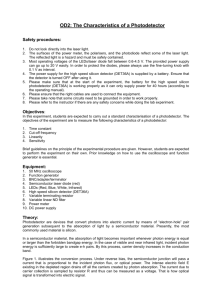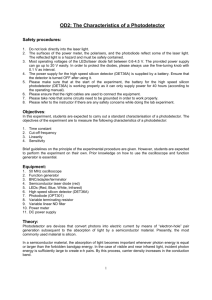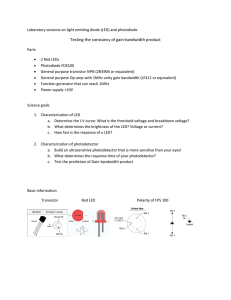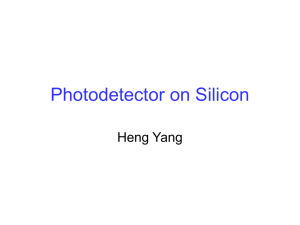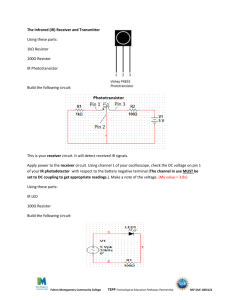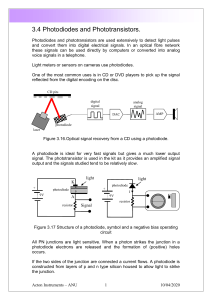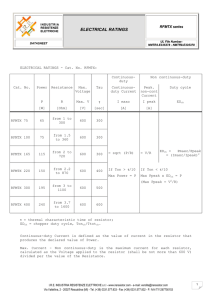OD2: Photodetector Characteristics
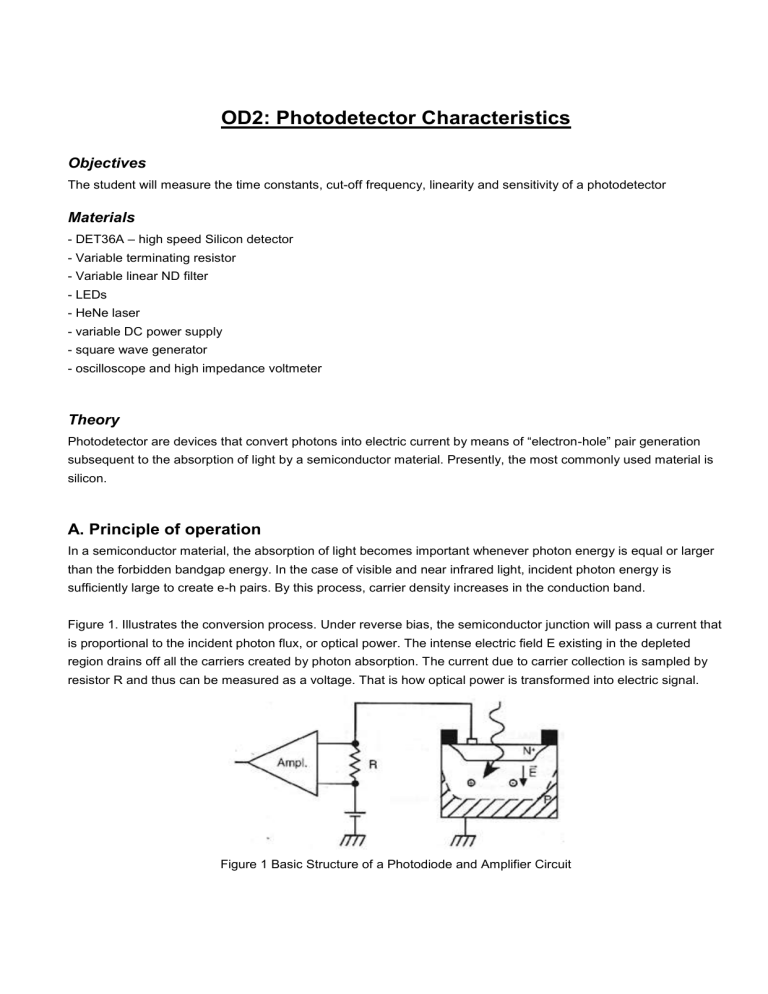
OD2: Photodetector Characteristics
Objectives
The student will measure the time constants, cut-off frequency, linearity and sensitivity of a photodetector
Materials
- DET36A – high speed Silicon detector
- Variable terminating resistor
- Variable linear ND filter
- LEDs
- HeNe laser
- variable DC power supply
- square wave generator
- oscilloscope and high impedance voltmeter
Theory
Photodetector are devices that convert photons into electric current by means of “electron-hole” pair generation subsequent to the absorption of light by a semiconductor material. Presently, the most commonly used material is silicon.
A. Principle of operation
In a semiconductor material, the absorption of light becomes important whenever photon energy is equal or larger than the forbidden bandgap energy. In the case of visible and near infrared light, incident photon energy is sufficiently large to create e-h pairs. By this process, carrier density increases in the conduction band.
Figure 1. Illustrates the conversion process. Under reverse bias, the semiconductor junction will pass a current that is proportional to the incident photon flux, or optical power. The intense electric field E existing in the depleted region drains off all the carriers created by photon absorption. The current due to carrier collection is sampled by resistor R and thus can be measured as a voltage. That is how optical power is transformed into electric signal.
Figure 1 Basic Structure of a Photodiode and Amplifier Circuit
B. Characteristics
The principle interesting characteristics of Photodetector are quantum efficiency, sensitivity, linearity, time constant, and leakage current.
Quantum efficiency
Pair generation by photon absorption is a random phenomenon characterised by the mean number of pairs created by each incoming photon. This probability, named quantum efficiency and noted
, depends upon photon wavelength and semiconductor type. For a typical silicon photodiode, for example, quantum efficiencies are
= 85% at 0.9 μm
= 20% at 1.06 μm
Sensitivity
By definition, sensitivity ( S ) is the current generated by the Photodetector per watt of incident optical power ( P op
).
For example, silicon photodiodes exhibit values of 0.6 A/W at 900 nm.
S
Current Intensity
P
op
For a given detector construction, sensitivity varies as a function of wavelength. At short wavelengths, quantum efficiency is low since absorption occurs very close to the surface. The light-generated photocarriers recombine very quickly in the N + region and consequently are not collected. At long wavelengths, the layer thickness is too small for complete absorption.
Once the quantum efficiency is known, the sensitivity can be deduced from the relationship
S
e hv where
is the quantum efficiency, e the electric charge, h planck’s constant, and v the radiation frequency.
Moreover, we already know that a proportional current I
0
corresponds to an incident power P
0
so that
I o
SP
0
Linearity
Linearity is another very important Photodetector characteristic. In fact, it is most important that the photocurrent varies linearly as a function of the incident energy flux, especially for analog signal reception. Typically, a photodiode exhibits a 100 dB dynamic range while keeping linearity within 1%. Under zero illumination conditions, the measured current corresponds to the total noise current including leakage current. This current therefore is named “dark current”. The experiment consists in measuring the signal output of the Photodetector as a function of attenuation of the light source. Since the light source used approximates a point source, its illumination varies in an inverse square law. Photodiode linearity then can be evaluated by plotting the amplitude curve on log-log paper.
We should then have a straight sloping line.
Time constant
The Photodetector time constant corresponds to the carrier travel time within the collection or depletion region. It depends upon the depletion zone thickness and carrier velocity. With the application of sufficient bias to the diode, we make sure that carriers reach their limiting velocity within this zone. In principle, the time constant of a typical
photodiode is 0.5 n s for 50 μm layer thickness. The actual values are much closer to 1 ns because the carriers crated outside the depletion zone are collected at a much slower rate, due to reduced field intensity in that area.
The determination of the Photodetector time constants is performed by measuring the output signal in response to a step input of light on the device. In practice, we apply a square wave signal to the input of the transmission module and measure the time interval required for the output signal to rise form 0-63% of its terminal value as shown in figure 2. This measured value gives the time consta nt τ of the detector.
100%
63%
Figure 2. Photodetector Time Constant
Procedures
A. Time constant
1. Pulse a RED LED with square wave with 1 kHz.
2. Set the variable load resistor to 50Ω.
3. Measure the time interval
corresponding to the detector time constant.
4. Adjust the value of the load resistor and the frequency of the square wave to other values and measure the time interval again.
5. Analyse your results.
B. Cut off Frequency
1. Pulse a RED LED with square wave with 1 kHz.
2. Set the variabl e load resistor to 50Ω.
3. Connect the photodiode output to the oscilloscope. You should now see the wave train.
4. By varying the frequencies, record the output voltage from the oscilloscope.
5. Try to vary the variable load resistor.
6. Plot a Log (amplitude)-frequency graph to determine the 3dB cut-off point.
7. Analyse your results.
C. Linearity
1. Place the HeNe laser in line with the variable ND filter and the photodetector.
2. Set the variable load resistor to 50Ω.
3. Place the LED in line with the variable ND filter and the photodetector.
4. Measure the value recorded by the oscilloscope as you vary the variable ND filter.
5. Try to vary the variable load resistor.
6. Plot your readings on log-log paper. Check the linearity of the PIN photodiode.
7. Analyse your results.
D. Sensitivity
1. Place the HeNe laser in line with the variable ND filter and the photodetector.
2. Set the variable load resistor to 50Ω.
3. Measure the value recorded by the oscilloscope as you vary the variable ND filter.
4. Change the photodetector with a power meter.
5. Measure the value recorded by the power meter as you vary the variable ND filter.
6. Try to vary the variable load resistor.
7. Change the LED to a different one and repeat the steps above.
8. Calculate the sensitivity of the photodetector.
9.
Analyse your results.
Report writing
1. The report should contain general information/comparison about the theory involved.
2. All the results of the measurements should be noted.
3. All results must be carefully analysed.
4. Comments on personal impression/experience during the lab session are to be added.
5. Report must be submitted in group to the technician in optical lab 2 at the latest 2 weeks after the session.
